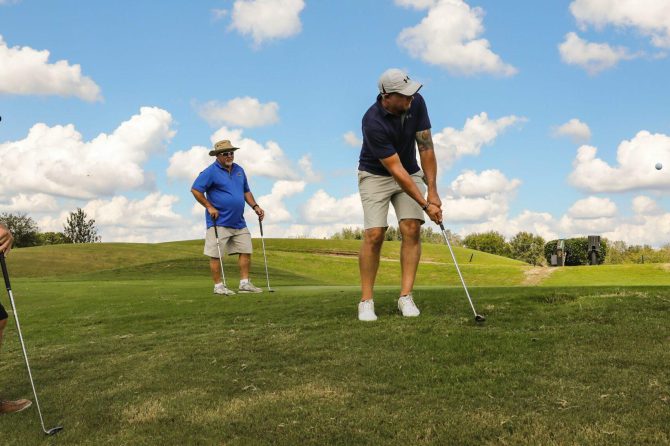Introduction
In recent years, the quest for optimizing golf performance has garnered meaningful attention within both athletic communities and scholarly circles. As golf is recognized as a complex, high-precision sport, enhancing performance requires a multifaceted approach that integrates physical fitness, biomechanics, and strategic training methodologies. This article aims to illuminate the critical role of evidence-based fitness strategies in enhancing golf performance, drawing upon contemporary research and empirical data to inform best practices. The relationship between fitness and golf performance is underscored by the necessity for not only physical endurance but also mental acuity throughout the game. Research highlights that components such as cardiovascular endurance contribute significantly to a golfer’s ability to navigate the rigors of an 18-hole course while maintaining concentration and strategic decision-making. Furthermore, strength and conditioning (S&C) programs have emerged as vital interventions that can substantially influence key performance metrics, including clubhead speed and overall swing mechanics.
As clinicians and coaches expand their understanding of individual golfer capabilities and limitations, it becomes imperative to adopt an academic framework grounded in scientific principles. This approach facilitates the identification of specific areas for improvement and the implementation of targeted training interventions. By systematically addressing the intricacies of physical planning, golfers can unlock their potential and refine their skills, ultimately enhancing their performance on the course.
This article will explore the integration of empirical findings in fitness and conditioning strategies that not only minimize injury risk but also enhance overall performance. Through a thorough review of the current literature, we seek to provide golfers and practitioners with actionable insights that support their continuous development in this intricate sport.
Understanding biomechanics in Golf Swing Efficiency
The efficiency of a golf swing is influenced by a multitude of biomechanical factors, which largely dictate the player’s ability to generate power while maintaining accuracy. Key components such as body alignment, joint angles, and timing are essential to execute an optimal swing. Research indicates that peak muscle activity during a swing reaches approximately 90% in amateur golfers, highlighting the strenuous nature of this athletic action. Additionally, muscle coordination and timing facilitate the transfer of energy, ultimately enhancing the speed and distance of the ball flight.
To analyze the mechanics further, a significant focus lies on the kinetic chain, which emphasizes how energy is transferred from the ground up through the legs, hips, torso, and into the arms and club. This principle can be exemplified using a double pendulum model, which demonstrates the dynamic transfer of energy as each segment accelerates. Understanding how changes in moment of inertia impact swing efficiency can aid golfers in adjusting their techniques to optimize performance while reducing the risk of injury, which is often linked to biomechanical faults during the swing.
Incorporating evidence-based fitness strategies can enhance biomechanical efficiency through targeted training that strengthens key muscle groups and improves adaptability. A structured approach may include:
- Strengthening exercises for core stability and lower body power, crucial for maintaining balance during the swing.
- Flexibility routines to promote a greater range of motion, allowing for an efficient rotation of the torso and hips.
- Neuromuscular training to refine timing and coordination, ensuring that the energy generated from the ground effectively translates into the swing.
Moreover, enhancing biomechanics for improved swing efficiency involves a sophisticated understanding of biomechanics, focusing on how body mechanics can enhance performance on the golf course. Key aspects of this approach include:
- Postural Alignment: Maintaining an optimal posture allows for a more fluid swing, minimizing stress on joints.
- Joint Mobility: Enhanced range of motion contributes considerably to the effectiveness of swing mechanics.
- Muscle Activation: Targeted strength training enhances the muscles involved in the swing, improving power and control.
For golfers, understanding the principles of biomechanics is crucial to maximizing swing efficiency. According to research, the synchronization of upper and lower body movements can greatly influence the overall mechanics of the swing. Key focus areas should include:
- Core Strength: A strong core stabilizes the body, allowing more power transfer during the swing.
- Hip Flexibility: Increased hip flexibility facilitates a deeper and more effective rotation, which is essential for generating distance.
- Shoulder Rotation: Proper shoulder mechanics contribute to a more efficient follow-through and better ball contact.
Additionally, precise analysis of swing mechanics through video feedback and performance tracking can guide adjustments in fitness regimens. A systematic approach involves:
| Biomechanical Factor | Impact on Swing |
|---|---|
| Coordination | Enhances timing and rhythm during the swing. |
| Balance | Improves stability at address and follow-through. |
| Force Generation | Increases clubhead speed and overall power. |
Physiological adaptations to Improve Endurance and Recovery
Enhancing endurance and recovery in golfers necessitates an understanding of key physiological adaptations that can be cultivated through targeted training. Muscle endurance, for example, plays an integral role in allowing golfers to maintain optimal performance throughout a round. Training regimens focused on higher repetitions with lower weights can stimulate various cellular mechanisms, leading to improved muscular stamina essential for executing multiple swings during play. Additionally, incorporating aerobic conditioning will enhance cardiovascular function, allowing for improved oxygen delivery to working muscles, thereby supporting sustained activity levels.
Effective recovery strategies are equally critical to maintaining physiological readiness between training sessions and rounds. Strategies such as active recovery, which includes low-intensity exercises to promote blood flow, can significantly speed up the recovery process. The implementation of hydration protocols and proper nutritional intake post-exercise ensures that essential nutrients are replenished, further enhancing muscle repair and recovery. The integration of restorative practices, such as active stretching and foam rolling, may also contribute to reduced muscle soreness and stiffness, facilitating a quicker return to peak performance levels.
Moreover, adaptations in metabolic efficiency can lead to improved energy utilization during prolonged play. Engaging in interval training can enhance the body’s ability to switch between aerobic and anaerobic systems, optimizing performance under varying conditions encountered on the golf course. This approach allows players to maintain a balance between power output during key moments, such as drives, and sustained endurance throughout the game. Summary Table:
| Physiological focus | Training Strategies | Benefits |
|---|---|---|
| Muscle Endurance | High-rep, low-weight exercises | Improved stamina for repetitive swings |
| Cardiovascular Health | Aerobic conditioning | Enhanced oxygen delivery to muscles |
| Recovery | Active recovery & hydration strategies | Faster muscle repair and reduced soreness |
Incorporating strength Training for Enhanced Power and Stability
Strength training serves as a cornerstone of a golfer’s fitness regimen, playing a crucial role in enhancing not only power but also stability during gameplay. Engaging in targeted strength exercises can lead to significant improvements in swing dynamics, allowing golfers to generate more force while maintaining proper form. Consequently, consistent resistance training can ensure that muscles develop in synergy, providing better control and precision when executing shots. The following benefits illustrate the importance of strength training for golfers:
- Increased Power: Developing muscular strength contributes to higher clubhead speed, which directly translates to increased distance.
- Improved Stability: Strengthening the core and stabilizing muscles enhances balance during the swing, helping maintain posture and alignment.
- Injury Prevention: Building resilience in key muscle groups can mitigate the risk of strains and sprains common in the sport.
A well-rounded strength training routine tailored for golfers should focus on specific functional movements that mimic the demands of a golf swing. exercises such as squats, deadlifts, lunges, and rotational movements are particularly effective. These exercises not only target major muscle groups but also promote coordination and balance, essential for a stable swing. Incorporating variations of these exercises, such as single-leg squats or cable woodchoppers, can further enhance strength and stability. A weekly training plan could include:
| Day | Exercise | Reps/Sets |
|---|---|---|
| Monday | Squats | 3 sets of 12 |
| Wednesday | Deadlifts | 3 sets of 10 |
| Friday | Lunges | 3 sets of 12 each leg |
Furthermore, integrating strength training with flexibility and endurance workouts can yield superior results for golfers. as strength enhances muscular power, flexibility exercises help prevent muscle tightness and improve range of motion, which are critical for executing a full golf swing. Additionally, cardiovascular conditioning supports overall fitness and recovery, allowing golfers to sustain energy levels for the entirety of a round. Therefore, a balanced approach to fitness that includes strength, flexibility, and endurance not only elevates performance on the course but also contributes to the longevity of a golfer’s career.
The Role of Flexibility and Mobility in Injury Prevention
Flexibility and mobility play critical roles in maintaining the integrity of a golfer’s biomechanics during swings and movements. Improved flexibility allows for greater range of motion in key muscle groups, which is essential for a powerful and efficient swing. In addition, enhanced mobility contributes to better overall body control, reducing the likelihood of compensatory movements that often lead to injuries. implementing flexibility and mobility training into a golfer’s routine can significantly decrease the risk of strains, sprains, and other common injuries related to repetitive motions.
In particular, certain stretches and mobility exercises target the major muscle groups engaged during a golf swing. These include the hips, shoulders, and thoracic spine. By focusing on the following benefits, golfers can enhance their physical capabilities and mitigate injury risks:
- Enhanced Performance: Greater flexibility leads to improved swing mechanics and explosiveness.
- Improved Posture: Proper alignment and posture during the swing can be achieved, decreasing undue stress on joints.
- Injury Prevention: Regular mobility work decreases muscle tightness, promoting a full range of motion.
To effectively incorporate these elements, golfers may benefit from a structured fitness regimen that includes dynamic stretches and resistance training. A sample routine could comprise:
| Exercise | Duration/Reps |
|---|---|
| Dynamic Shoulder Stretch | 10-12 reps |
| Hip Flexor Stretch | 30 seconds per side |
| Torso Rotation | 10-15 reps |
Regular engagement in these activities will bolster flexibility and mobility, creating a well-rounded approach to injury prevention and enhancing overall golf performance.
Nutrition Strategies to Support Optimal Performance on the Course
To achieve peak performance on the golf course, emerging golfers must prioritize a balanced intake of macronutrients. Carbohydrates should form the foundation of their diet, providing the necessary energy for sustained activity. Complex carbohydrates from sources such as whole grains, fruits, and vegetables are particularly beneficial as they release energy gradually, helping maintain performance throughout the round. Proteins are essential for muscle repair and recovery, with lean meats, dairy, and plant-based options like beans and legumes being excellent choices. Fats, particularly healthy fats found in nuts, seeds, and avocados, should not be neglected as they support overall health and provide long-lasting energy.
Furthermore, incorporating nutritional science into daily routines is vital. A well-structured nutritional plan involves a deep understanding of macronutrients and micronutrients, ensuring a balanced intake that aligns with the energy demands of the sport. Carbohydrates, as the primary energy source, should be emphasized, particularly in the form of complex carbs such as whole grains, fruits, and vegetables. This approach not only supports sustained energy levels during lengthy rounds but also aids in optimizing glycogen stores for recovery.
Hydration plays a critical role in optimizing performance, and golfers must be diligent in their fluid intake before, during, and after play. It is indeed advisable to consume water consistently throughout the day, aiming for at least 2-3 liters, depending on individual needs and environmental conditions. During the game, simple yet effective hydration strategies include sipping water regularly and utilizing electrolyte beverages to replace lost minerals. As a guideline, golfers might consider a hydration plan like the following:
| Time | Recommended Intake |
|---|---|
| Before Round | 500-750 ml of water |
| During Round | 150-250 ml every 15-20 minutes |
| After Round | At least 750 ml to replenish |
Post-game nutrition is equally crucial, as it aids in recovery and prepares the body for the next event. A snack or meal that incorporates both protein and carbohydrates should be consumed within 30 minutes of finishing the round to maximize recovery benefits. Options may include a protein shake with a banana, Greek yogurt with berries, or a turkey sandwich on whole-grain bread. Moreover,hydration strategies should not be overlooked.As golfers frequently enough contend with extended hours on the course, maintaining adequate fluid balance is crucial to prevent fatigue and dehydration. Electrolyte-rich beverages can be particularly effective when consumed systematically during play. A suggested hydration schedule could be as follows:
| Time | Fluid Intake |
|---|---|
| Before Tee-off | 16-20 oz of water |
| During Round (every 4-6 holes) | 8-12 oz of an electrolyte drink |
| Post-Round | 20-24 oz of water and recovery shake |
By strategically implementing these nutritional principles, golfers can achieve greater durability and enhance their overall well-being, leading to improved performance on the course. An integrated approach not only empowers athletes to excel but also fosters long-term health within the sport.
The Way Forward
optimizing golf performance through evidence-based fitness strategies offers a robust framework for both amateur and professional golfers seeking to enhance their capabilities on the course. The integration of scientific principles into training regimens facilitates a nuanced understanding of the biomechanics and physiological demands intrinsic to the sport. As noted, the integration of fitness science into golf training represents a transformative approach to enhancing athletic performance on the links. By leveraging principles of biomechanics and exercise physiology, golfers can optimize their swing mechanics, elevate endurance levels, and reduce the risk of injury.
Ultimately, by embracing an academic approach to physical enhancement, golfers can not only elevate their skills but also cultivate a deeper appreciation for the athletic rigor required in golf. This ongoing journey of improvement and adaptation embodies the essence of the sport, paving the way for sustained excellence and enjoyment on the course.




